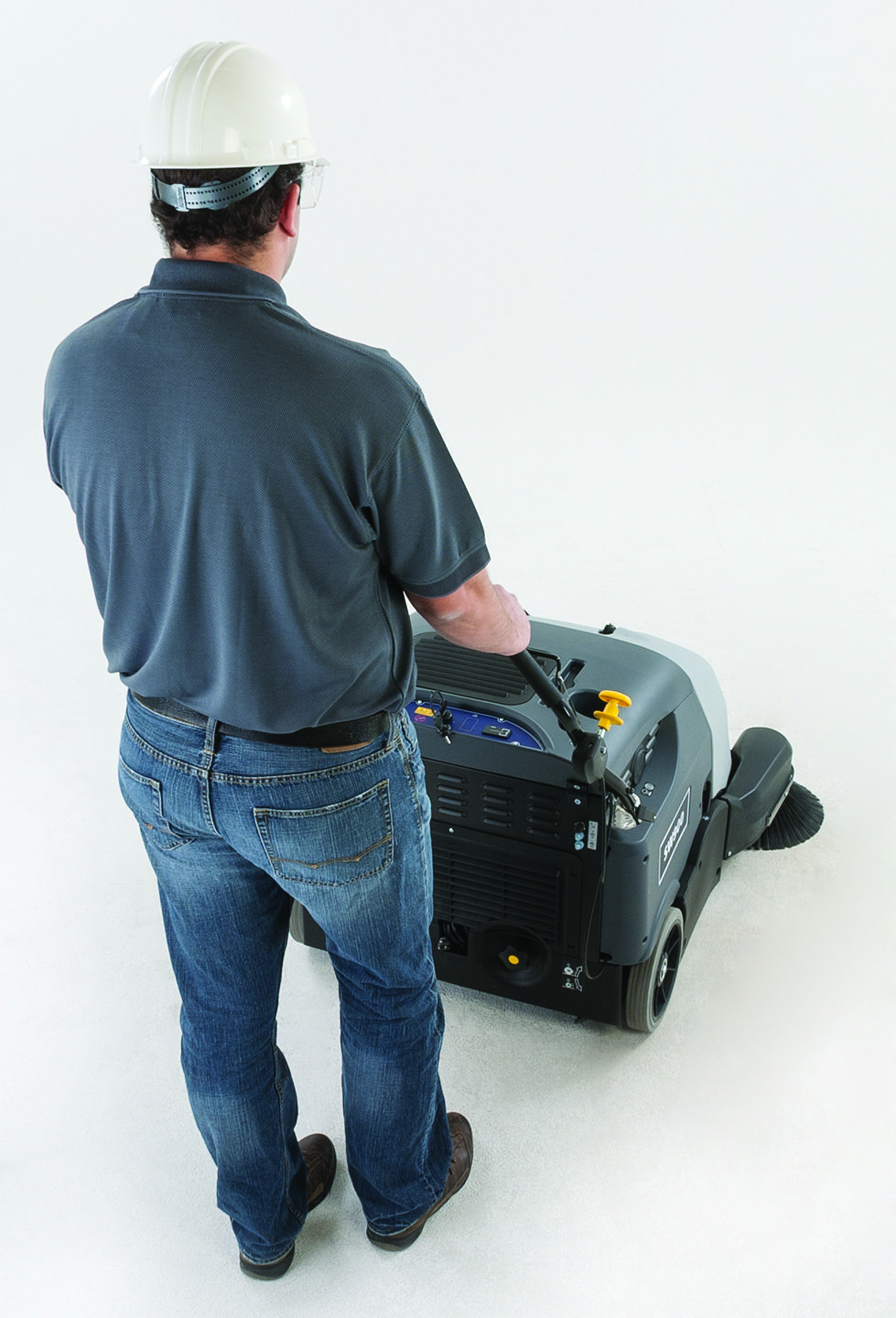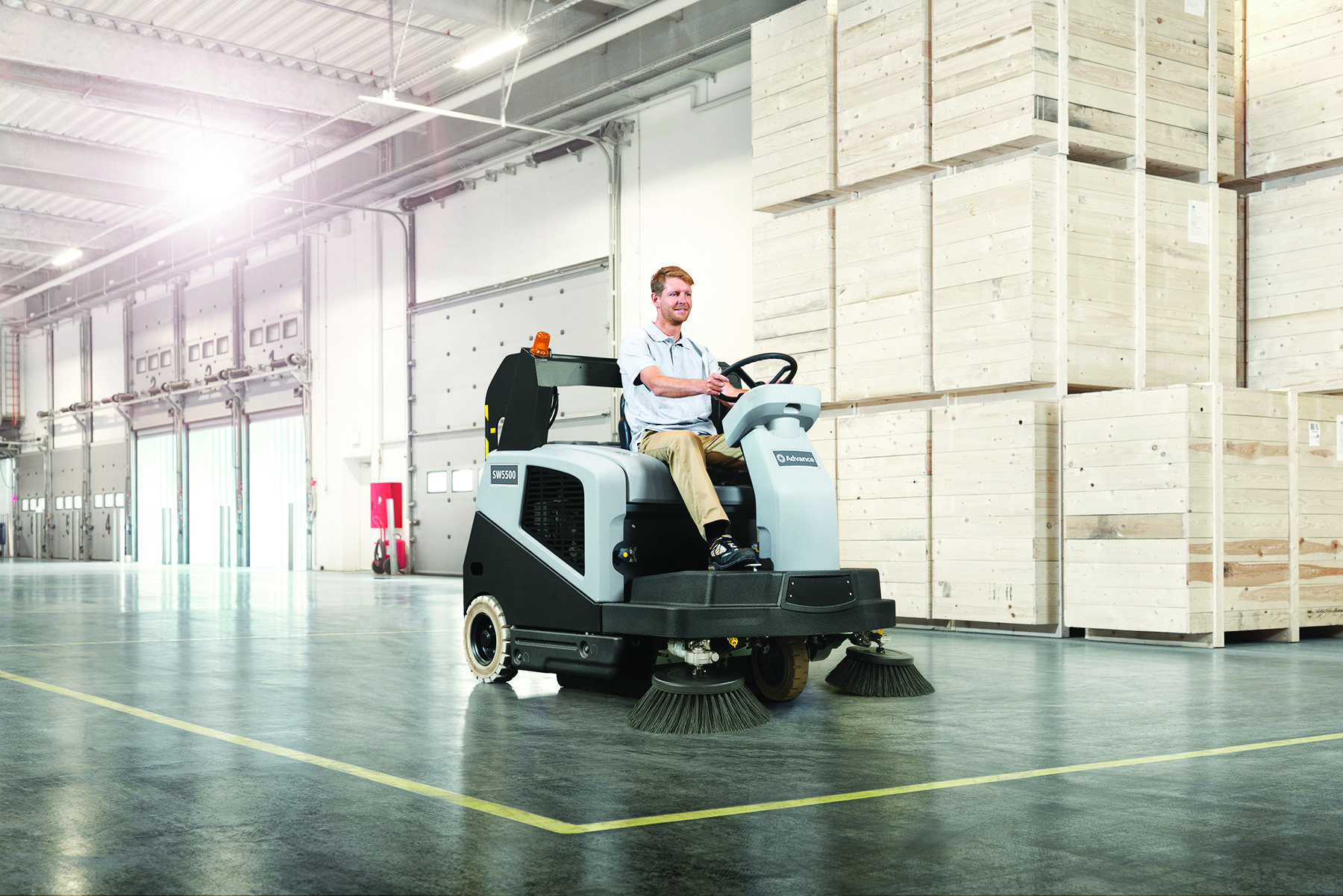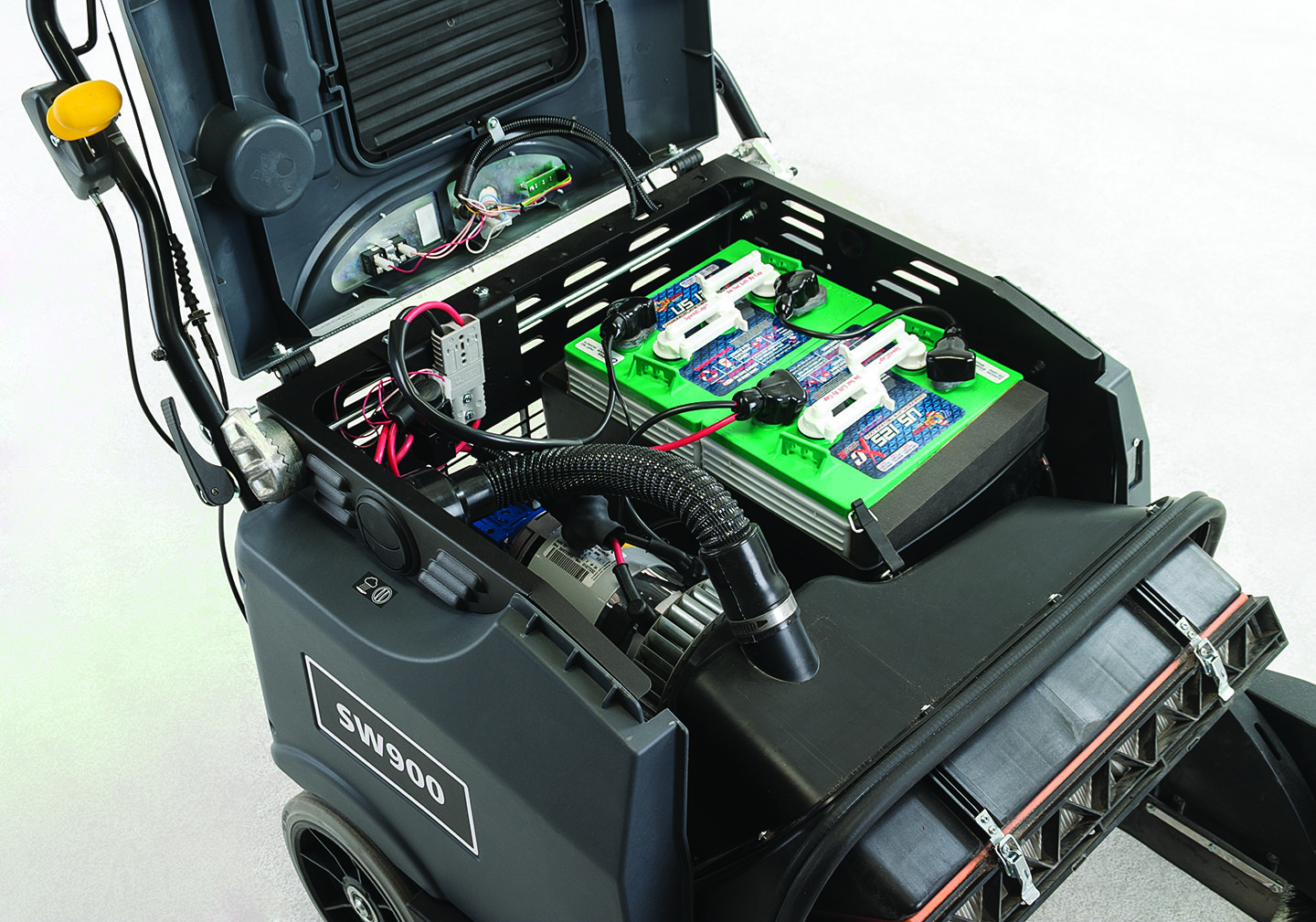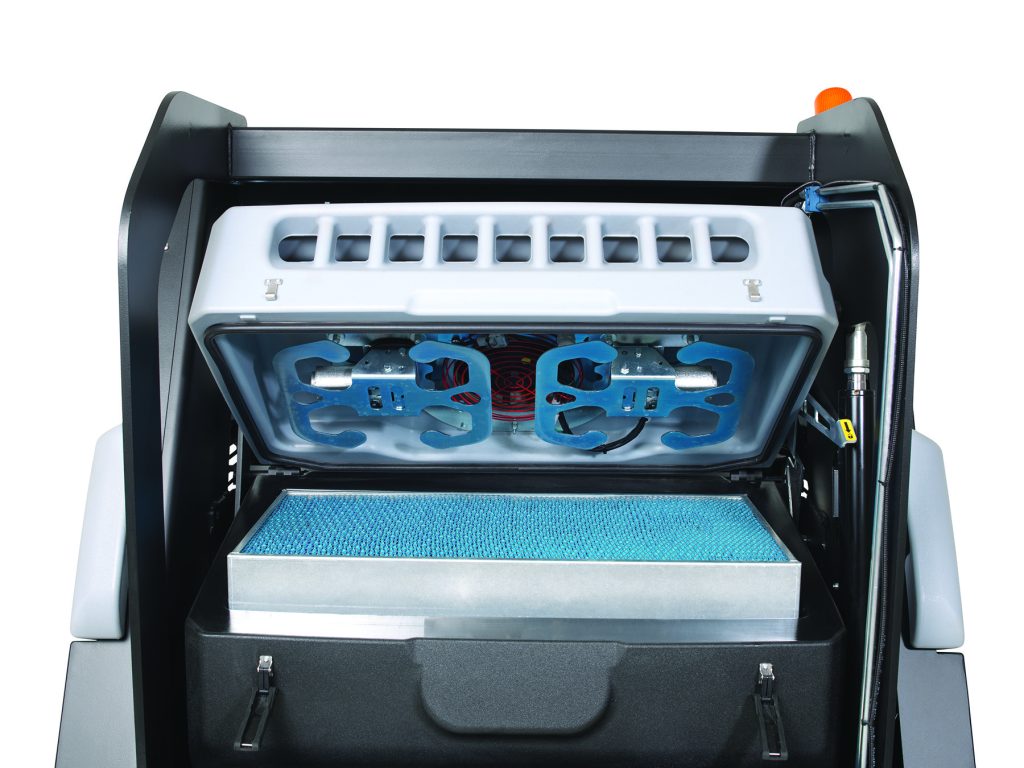The right janitorial equipment is crucial for maintaining cleanliness in large warehouses, industrial areas, factories, and other facilities.
What do I mean by the “right” equipment?
Most cleaning tasks can be completed with a variety of tools or equipment. For example, if there’s a spill, you clean it with a mop or a wet/dry vac. If there’s a carpet stain, you can remove it with a carpet brush or a carpet extractor.
However, the most effective equipment for sweeping and light floorcare is an industrial floor sweeper.
If you’re looking to enhance your floor care routine and boost staff productivity, industrial floor sweepers eliminate the need for brooms. Floor sweepers remove and contain dirt, dust, sand, crumbs, pet dander, leaves, paper, sawdust, or other particulate matter and small debris in one step.
In this comprehensive guide, we’ll delve into the world of industrial floor sweepers, exploring how they work, the different types, the surfaces they can be used on, and everything else a business owner needs to know before purchasing one.
What is a Floor Sweeper?
An industrial floor sweeper is a cleaning machine designed to efficiently collect and remove dirt, dust, and small debris.
What Surfaces Can a Floor Sweeper Be Used On?
Floor sweepers can be used on hard and soft floors, indoors and outdoors. Some examples of surface types that an industrial floor sweeper can be used to clean include:
- Tile
- Stone
- Vinyl
- Concrete
- Carpet
Why Use a Floor Sweeper?
Industrial floor sweepers come in various sizes and can be used in most industrial spaces, from warehouses to assisted living facilities.
Models differ in features like weight, cleaning path, dumping system, and brush configuration to better suit the space you need to be cleaned, whether small, medium, or large.
All of these sizes and features culminate in a machine that far exceeds the efficacy of a traditional broom or manual sweeper.
Industrial floor sweepers, like brooms, are faster and more efficient than traditional options. Thanks to their motorized design, they can cover large areas quickly, reducing the time and effort needed to complete cleaning tasks.
These machines also boast impressive dust control features that traditional methods lack, minimizing the amount of airborne dust particles sent into the air during the cleaning process. They also provide consistent cleaning results each time, adding to an overall uniform and professional appearance
While the initial cost may be higher, increased efficiency, higher productivity, and better results contribute significantly towards long-term savings.
When to Use a Floor Sweeper
These machines are the perfect solution for light, bulky debris, such as dirt, paper waste, leaves, packing materials, and dust. Some models are even equipped to handle heavier debris and debris that’s adhered to the floor, making them ideal for food handling and processing facilities.
Unlike manual cleaning, industrial floor sweepers deliver superior results and enable deep, thorough cleaning of both indoor and outdoor spaces.
What Are the Different Types of Floor Sweepers?
There are two different types of industrial floor sweepers:
- Walk-Behind Floor Sweepers
- Ride-On Floor Sweepers
Walk-Behind Floor Sweepers
Walk-behind floor sweepers are popular for indoor cleaning jobs, particularly in small-to-medium spaces.

These models are typically smaller than ride-on models. They’re also generally easier to navigate through tight spaces because the operator has a high degree of control over the direction and momentum of the machine. As a result, walk-behind floor sweepers are ideal for use in areas with many obstacles, doorways, and narrow passages.
Additionally, these machines can go up and down inclines that are too steep for ride-on floor sweepers.
Advantages
Walk-behind floor sweepers have two major advantages over ride-on floor sweepers. The first is that they are able to operate in small areas and narrow passages. The second is that they can be far more affordable.
Disadvantages
While you can use a walk-behind floor sweeper to clean the same area as a ride-on floor sweeper, you have to consider that it will take longer. This is due to factors like size, weight, speed, and operator fatigue.
Ride-On Floor Sweepers
Ride-on floor sweepers are best suited for indoor and outdoor cleaning jobs, particularly in medium-to-large spaces. These models are bigger than the walk-behind models.
Most ride-on floor sweepers have ergonomic seats and easy-to-reach controls for maximum user comfort. As a result, fatigue is virtually nonexistent, enabling operators to clean for much longer than they would with a walk-behind floor sweeper. On top of that, ride-on floor sweepers are generally more powerful and can provide a deeper clean.

In addition to their power, these machines are highly productive. This is partly due to their large size, which allows for a wider sweeping path and larger debris hopper.
Advantages
Ride-on floor sweepers have two distinct advantages over walk-behind floor sweepers: they’re bigger and more powerful. More size and power allows for better and faster cleaning, especially in large, open areas.
Disadvantages
That being said, there are also two disadvantages to using a ride-on floor sweeper. The first is that they’re generally more expensive and the second is that they’re limited to use in large, open areas.
How Does a Floor Sweeper Work?
Industrial floor sweepers operate through a combination of internal components and systems, listed below:

- Sweeping system
- Suction system
- Filtration system
- Filter cleaning system
- Debris hopper
- Dumping system
Components of a Floor Sweeper
Let’s review each component and system, examining how they work together to produce excellent cleaning results.
1. Sweeping System
The sweeping system consists of one or more side brushes and a center brush.
The side brush conveys dirt, dust, and small debris towards the machine’s center brush. Once at the center brush, any debris is swept into the debris hopper, where it will remain until the hopper can be emptied.
2. Suction System
The suction system, or suction unit, consists of a fan that creates enough suction to pick up any dust that is raised by the main brush. The suction unit works with the filtration unit to capture dust.
3. Filtration System

The filtration system ensures that an industrial floor sweeper only releases clean air while in use by trapping dust and similarly sized particulate matter in a filter.
4. Filter Cleaning System
Some industrial floor sweepers come equipped with a filtration cleaning system, called a filter shaker. The filter shaker keeps the filter clean for optimal performance. These can be manual or electric.
5. Debris Hopper
The debris hopper collects dirt and small debris throughout the cleaning process. There are two types of debris hopper systems, front-loading and rear-loading.
Front-Loading
In a front-loading system, also called a dustpan system, the main broom sweeps debris directly into a hopper that sits at the front of the machine.
This type of system can be found on most walk-behind floor sweepers. It’s suggested for use with heavy debris, and features a hopper that can be manually removed and dumped into a bin. However, the hopper must be emptied after it reaches 60% capacity.
Rear-Loading
In a rear-loading system, also called a top-loading or over-the-top system, debris collected by the main brush is dropped into a hopper that sits at the rear of the machine.
This type of system can be found on most large ride-on floor sweepers. It’s suggested for use with light and bulky debris. Unlike the front-loading system, this system can fill to 100% hopper capacity before needing to be emptied.
6. Dumping System
Some industrial floor sweepers have an automatic dumping system, which empties the hopper at the press of a button. Others need to be emptied manually, which involves removing the hopper and dumping it out by hand.
Final Thoughts
Boost staff productivity and eliminate the need for multiple floor cleaning tools like brooms and pans with inudtsrial floor sweepers.
If you’re interested in seeing an industrial floor sweeper in action, reach out to set up an equipment demo. We have a variety of models available to fit your facility’s cleaning needs.
Unsure what the cleaning needs of your facility are? Don’t worry! Call an Imperial Dade facility near you to get in touch with a janitorial equipment team. One of our Equipment Experts will be happy to perform a free evaluation of your facility to help determine what your cleaning needs are and whether an industrial floor sweeper is the best equipment to address them.
